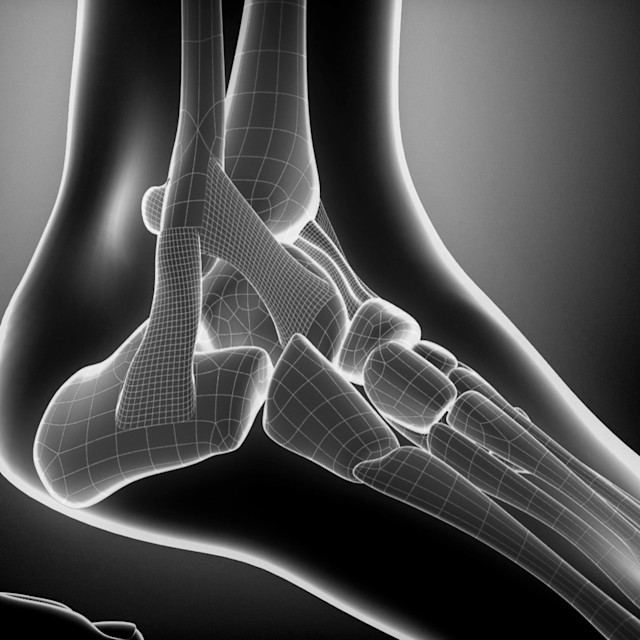From ensuring proper lifting form to supporting explosive power, ankle mobility is vital.
Natalia Perzyna first noticed a problem after she’d added barbell back squats to her weight room routine. The next day, her knee hurt. It took her a few sessions, closely examining her form and movements with her knowledge as a certified personal trainer and Equinox Barre and Pilates instructor to find the culprit: her ankles.
“I was always aware of my ankles, being a dancer, and I also played soccer, so my ankles definitely took some beating when I was growing up,” says Perzyna. “But I didn't realize how deficient I was in ankle mobility until I started lifting weights seriously.”
When we’re considering injury prevention and longevity, we think about our knees, our backs, even our hips — but ankles? Turns out prioritizing ankle strength and flexibility (and a combination of the two, or what Perzyna means when she says “ankle mobility”) can help improve balance, performance, and dynamic movement in workouts.
“The ankle is the middleman and the communicator between your foot and your leg, essentially,” says Perzyna. “And it needs to be flexible, strong, and stable.” Here are a few ways ankle mobility can improve your performance and longevity.
RELATED: Introducing Barre Beyond
The Ankle and Balance Connection
One of the biggest arguments for working on ankle mobility is its connection to balance. The more robust and flexible the ankle, the better your balance. Prioritizing ankle mobility has both short-term and long-term effects. If you’re spending time in yoga or barre classes, it means better performance in balance poses. But, says Perzyna, you’ll also reap enormous benefits for simply living.
“For seniors, it's beneficial for them by simply supporting their daily activities,” she says. “Going up and down stairs. Preventing falls and injuries. When I work with older clients, we’re doing a lot of training around the ability to sit down and stand up from the floor without using your hands — and that requires the ankles.”
Ankle Mobility Improves Form
If you spend most of your time in the weight room, ankle mobility could positively benefit your workout — and potentially prevent injury.
“When I first started lifting, my knees couldn’t pass over my toes in my squat, so my hips would compensate, and then I would experience low back pain or hip pain,” says Perzyna. “And that's where ankle mobility comes in. If you watch the mechanics of a squat, everything should be moving together as one, but with somebody who has limited ankle mobility, you can see that the knees and the hips will continue to move, but the ankles — specifically, the angle of the ankle to the knee and the foot — will kind of stop. And that's where you run into problems with other joints compensating more than they should.”
RELATED: Forged at Equinox: Aaron and Anastasia
The Ankles as Explosive Power
Working on improving ankle mobility is also beneficial for speed and power — must-haves for basketball players making jump shots, sprinters, even tennis players, says Perzyna.
“You look at ballet dancers — especially male dancers — and you watch them leap across the floor. You see how low they get in their legs before taking off and how that projects them higher. You see the rolling of the foot, the strength of the ankles and the calves — up the chain — and then they land without making a sound. The ankle is like a shock absorber. It’s incredible athleticism,” says Perzyna. “That same explosive power can benefit so many other sports and workouts, which is why so many sports teams integrate barefoot training and other ankle mobility exercises into their training.”
The Body — Yes, Even Our Ankles — Is Adaptable
As for improving ankle mobility, especially if you know you need improvement, Perzyna has a few tips. “You see in other cultures, particularly Asian cultures, people are conditioned to squat. They sit in a squat to wash their dishes, do their laundry. Your body can adapt to whatever you put onto it.”
Perzyna's best advice? Practice daily. Add calf raises to the start or end of your workout — no equipment necessary. “Use a curb after your walk or run to lift your heels up. It really can be that simple,” she says.
Or take a barre class, which will naturally improve ankle strength and flexibility over time (all those pliés!). “I have a guy who comes regularly to my classes mainly to warm his ankles up,” she says. “Then he heads to the weight room to do his squats. It’s a perfect combination for his routine. When you’re in a barre class, you’re barefoot on flat ground. It’s the purest communication between your mind, body, and ground. You’re using all the muscles in your feet and ankles to find balance — and you’re training the base that holds you up in every aspect of your life."
